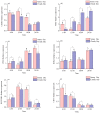Daily Rhythmicity of Muscle-Related and Rhythm Genes Expression in Mackerel Tuna (Euthynnus affinis)
- PMID: 37759610
- PMCID: PMC10525508
- DOI: 10.3390/biology12091211
Daily Rhythmicity of Muscle-Related and Rhythm Genes Expression in Mackerel Tuna (Euthynnus affinis)
Abstract
The aim of this study was to investigate the circadian rhythm of muscle-related gene expression in mackerel tuna under different weather conditions. The experiment was carried out under two weather conditions at four sampling times (6:00, 12:00, 18:00, and 24:00) to determine the expression of growth, function, and rhythm genes: white muscle rhythm genes were rhythmic on sunny and cloudy days, except for PER3 and RORA; all functional genes had daily rhythmicity. Red muscle had daily rhythmicity on both sunny and cloudy days; functional genes had daily rhythmicity except for MBNL. The expression levels of the rhythm gene PER1 were determined to be significantly different by independent t-test samples in white muscle at 6:00, 12:00, 18:00, and 24:00 under different weather conditions; the expression levels of the functional genes MBNL and MSTN were both significantly different. In the red muscle, the expression of the rhythm genes PER3, REVERBA, and BMAL1 was determined by independent t-test samples at 6:00, 12:00, 18:00, and 24:00 on cloudy and sunny days; the functional gene MBNL was significantly different. The present study showed that mackerel tuna muscle rhythm genes and functional genes varied significantly in expression levels depending on weather, time of day, and light intensity and that the expression levels of myogenic genes were closely related to clock gene expression. The fish were also able to adapt to changes in light intensity in different weather conditions through positive physiological regulation.
Keywords: biological clock; daily expression; mackerel tuna; muscle; related gene expression.
Conflict of interest statement
The authors declare no conflict of interest.
Figures







Similar articles
-
Daily rhythmicity of clock gene transcript levels in fast and slow muscle fibers from Chinese perch (Siniperca chuatsi).BMC Genomics. 2016 Dec 8;17(1):1008. doi: 10.1186/s12864-016-3373-z. BMC Genomics. 2016. PMID: 27931190 Free PMC article.
-
The Influence of Short-term Fasting on Muscle Growth and Fiber Hypotrophy Regulated by the Rhythmic Expression of Clock Genes and Myogenic Factors in Nile Tilapia.Mar Biotechnol (NY). 2018 Dec;20(6):750-768. doi: 10.1007/s10126-018-9846-0. Epub 2018 Sep 4. Mar Biotechnol (NY). 2018. PMID: 30182177
-
The effect of high fat diet on daily rhythm of the core clock genes and muscle functional genes in the skeletal muscle of Chinese soft-shelled turtle (Trionyx sinensis).Comp Biochem Physiol B Biochem Mol Biol. 2017 Nov;213:17-27. doi: 10.1016/j.cbpb.2017.07.002. Epub 2017 Jul 17. Comp Biochem Physiol B Biochem Mol Biol. 2017. PMID: 28729066
-
Functional central rhythmicity and light entrainment, but not liver and muscle rhythmicity, are Clock independent.Am J Physiol Regul Integr Comp Physiol. 2006 Oct;291(4):R1172-80. doi: 10.1152/ajpregu.00223.2006. Epub 2006 May 18. Am J Physiol Regul Integr Comp Physiol. 2006. PMID: 16709646
-
Chronotherapeutic strategy: Rhythm monitoring, manipulation and disruption.Adv Drug Deliv Rev. 2010 Jul 31;62(9-10):859-75. doi: 10.1016/j.addr.2010.01.006. Epub 2010 Feb 25. Adv Drug Deliv Rev. 2010. PMID: 20188774 Review.
References
-
- Orem J.M. Rhythms of Life: The Biological Clocks that Control the Daily Lives of Every Living Thing. Q. Rev. Biol. 2005;80:266–267. doi: 10.1086/433139. - DOI
-
- Yan H., Zhu W., Wu P. Analysis of the rhythms of gene expression in the liver and heart biological clocks of Siniperca chuatsi. Acta Hydrobiol. Sin. 2016;40:243–251.
Grants and funding
- ZDKJ2021011/Hainan Major Science and Technology Project
- SKJC-2022-PTDX-015/Project of Sanya Yazhou Bay Science and Technology City
- 2020TD55/Central Public-Interest Scientific Institution Basal Research Fund, CAFS
- 2021SD09/Central Public-Interest Scientific Institution Basal Research Fund South China Sea Fisheries Research Institute, CAFS
- 323QN331/Hainan Provincial Natural Science Foundation of China
LinkOut - more resources
Full Text Sources
Miscellaneous

